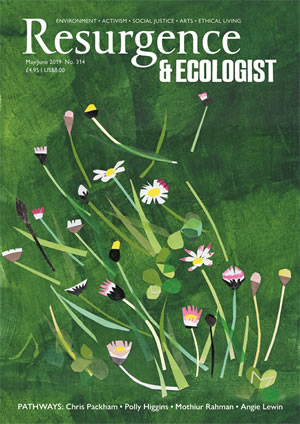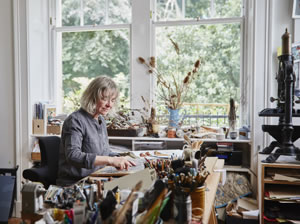Angie Lewin is a master printmaker. Her beautiful images of plants, landscapes and still lifes marry technical sophistication and a subtle palette with a direct simplicity of subject matter. Through a variety of disciplines – wood engraving, silk screen printing and lithography as well as her designs for wallpapers, ceramics and textiles – she restores to her audience a child’s view of Nature, close up and full of wonder. Through all her work runs the central inspiration of Nature, wild as often as cared for, with plants, shells and feathers placed heroically centre stage against elemental backdrops of moonlit sky or rocky coastline. Lewin’s graphic line seeks out the order in Nature, finding everywhere symmetries and geometries, and evolving over many years a vocabulary of stylised elements. Yet her compositions also celebrate wildness, the anarchic tumbling and tangling of vegetation, the tearing winds and stormy seas of Britain’s outskirts, and the raw beauty of the lonely Norfolk coastline, remote Scottish islands and rugged mountain landscapes she seeks out. In May this year, the Sarah Wiseman Gallery in Oxford opens its second solo show of Lewin’s prints, including new work inspired by Lewin’s most recent trip to North Uist in the Outer Hebrides. The title, Meadow and Shore, encapsulates Lewin’s work – gentle and domesticated, yet reaching out to the wilderness.
Lewin was born far inland in Cheshire, on the edge of the Peak District, in a cotton mill village, the youngest of four and the only girl. Her father, trained as a blacksmith, turned to engineering during the second world war. Lewin comments: “He would do interesting informational drawings, quite pared back.” She also benefited from his keen gardening: “I spent a lot of time outside on my own, playing with plants, making daisy chains, and later on sketching.” Her academic girls’ grammar school in Macclesfield did not value art but nevertheless supplied a good art teacher in the sixth form, and Lewin went on to study sculpture at the Central School of Art and Design, in London. “I liked to go out into forests and woods and make environmental sculpture,” she says. During her first term, however, the students were required to do printmaking, and, Lewin says, “The minute I walked into the print room I thought, this is what I ought to do. It was the physicality of the lino-cutting, the beautiful Colombian presses, the rollers, all the lovely tools…” She also found liberating the way that in printmaking the final image emerges through several stages: “You end up overlaying transparent colours to get these accidental colours that just pull the whole thing together. It is a magical process, partly because you are giving yourself over to it.”
While at college, Lewin was drawn to Japanese printmaking and produced images of Samurai armour and other Japanese subjects, but her degree show was quite different. Her father was a keen fly-fisher and would make his own flies from assorted feathers he collected and coloured yarns. “They are so tiny, but the detail and the craftsmanship are so fine, and I was fascinated by the idea that they are then so alluring to trout.” She created a number of large-scale prints of these flies. “I exaggerated them to make them incredibly graphic,” she says. Lewin suggests that it was from those prints that her entire practice has evolved, slowly turning to landscape, feathers and plants as subject matter. Still committed to her urban experiment, Lewin took a postgraduate course in printmaking at Camberwell School of Arts and Crafts, at the same time working as a commercial illustrator for various magazines and on book projects. She became aware of earlier British printmakers like Edward Bawden and Eric Ravilious and was inspired by the Festival of Britain period of printmaking, when artists like Henry Moore and John Piper were engaged as eagerly in printmaking and textiles as designers like Lucienne Day and Enid Marx. She also came across the neo-Romantic landscape painter Alan Reynolds and recognised an immediate affinity. It turned out that he too had designed fabrics. “Why wouldn’t you want to design beautiful things if you can?” Lewin asks.
It was in the mid-nineties, nearly a decade later, that Lewin, by then living with her husband Simon in North London, decided to change direction. She did an RHS horticultural course, followed by a two-year garden design course: “I liked the idea of designing with plants. In the morning there would be cuttings of plants in jam jars and you would have to draw them and then research the plants and decide how to use them.” She adds, “You would be made to think about the intrinsic thing each plant brings to the garden.” Inspired by all the visits to gardens, in 1998 the couple moved to Norfolk, where Lewin combined her printmaking with creating gardens. At their first house, the formality of a box-hedged garden was softened by allowing weeds to mix in the borders with cultivated flowers. Their second home offered a large space full of wild flowers at the front of the house, a bit of lawn at the back, and fruit trees. Here, in 2005, they founded the textile company St Jude’s, which still operates, working with designs by Lewin and other artists. They also run a book imprint, Random Spectacular, its most recent publication a book about pebbles written by Christopher Stocks and illustrated by Lewin.
Increasingly landscape has crept into Lewin’s prints. “The landscapes where I spend most time are often remote. And although I just give a hint of the landscape behind the plant forms, the sense of place is fundamental. The atmosphere and the weather are so important to me. The plants epitomise the landscape.” Lewin is very clear that her images are not botanically accurate. What her drawings seize and her prints accentuate is the essential character of each plant, and what it gives to the landscape. She says of her new print ‘Wild Shore’: “Wild carrot, yellow rattle and clover were growing amongst the fine coastal grasses, softening the line between the machair and the pebbles which fringe the white sand beaches.” It is no wonder, given Lewin’s sensitivity to such wild places, that seven years ago the couple moved to Scotland. They divide their time between Edinburgh and a remote cottage in Speyside, with frequent visits to the Outer Hebrides. “The wild flowers are incredible there. There is no one on the beach. You are able quietly to look at the landscape and walk.” It is this spirit of freedom that breathes in Angie Lewin’s work.
Meadow and Shore, a solo exhibition of new prints by Angie Lewin, runs from 4 to 25 May 2019, at the Sarah Wiseman Gallery, Oxford. www.wisegal.com







